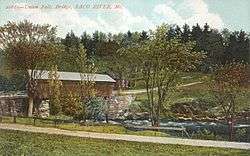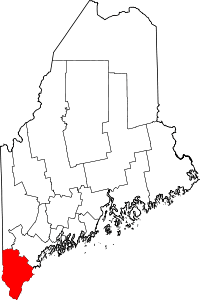Dayton, Maine
Dayton is a town in York County, Maine, United States. The population was 1,965 at the 2010 census. It is part of the Portland–South Portland–Biddeford, Maine metropolitan statistical area. Dayton is one of the smallest towns in York County.
Dayton, Maine | |
|---|---|
 Union Falls Bridge, c. 1908 | |
 Dayton | |
| Coordinates: 43°32′34″N 70°34′46″W | |
| Country | United States |
| State | Maine |
| County | York |
| Incorporated | 1854 |
| Government | |
| • Type | Board of Selectmen |
| • Selectman, Chair | Theodore Poirier |
| • Selectmen | Scott Littlefield Gerry Taylor |
| Area | |
| • Total | 18.40 sq mi (47.66 km2) |
| • Land | 17.89 sq mi (46.33 km2) |
| • Water | 0.51 sq mi (1.32 km2) |
| Elevation | 220 ft (67 m) |
| Population | |
| • Total | 1,965 |
| • Estimate (2012[3]) | 2,006 |
| • Density | 109.8/sq mi (42.4/km2) |
| Time zone | UTC-5 (Eastern (EST)) |
| • Summer (DST) | UTC-4 (EDT) |
| ZIP code | 04005 |
| Area code(s) | 207 |
| FIPS code | 23-16725 |
| GNIS feature ID | 0582434 |
| Website | http://www.dayton-me.gov/ |
History
The area was once inhabited by the Sokokis (or Saco) Indians, who hunted and fished along the Saco River. The old Sokokis Trail is now Route 5, which passes through Dayton. In 1664, Major William Phillips purchased from the sagamore the land which would become Little Falls Plantation—today the towns of Hollis, Dayton and part of Limington. In 1728, a stockaded fort which contained a trading post was built a half mile below Union Falls. Called the Saco Truck House or Saco Block House, the garrison was maintained throughout the French and Indian War until the fall of Quebec in 1759.[4]
Settlers arrived in 1753, and lumbering became a principal industry. Logs were rolled down the banks of the Saco River and floated to sawmills at Saco. Nathaniel Goodwin established the first local mill in 1782 at Goodwins Mills, where falls in Swan Brook drop 33 feet (10 m). A sawmill and gristmill were erected at Union Falls (then called Hopkinson's Mill) in 1806. Tanneries were built, and land was cleared for farms. In 1798, Little Falls Plantation was incorporated as Phillipsburg, in honor of Major William Phillips—but only until 1810. Considered difficult to pronounce and write, the Phillipsburg was changed to Hollis. Then, in 1854, the southern part of Hollis petitioned the state legislature to become a separate town. Permission was granted, and the community was named Dayton after Thomas Day, who submitted the petition.[5]
In 1860, Dayton voted to build at Union Falls a covered bridge, 112 feet (34 m) long and 18 feet (5.5 m) wide, connecting to Buxton. The span was blown up in 1921 by the Clark Power Company, an event filmed as part of a melodrama by the Pine Tree Moving Picture Corporation of Portland. The Great Fires of 1947 destroyed two-thirds of Dayton, including 27 homes, 4 barns and the town hall. In 1951, the Central Maine Power Company built a hydroelectric dam between Salmon Falls and Union Falls, submerging the scenic gorge. Once a community of dairy farms, Dayton is now primarily residential.
Geography
According to the United States Census Bureau, the town has a total area of 18.40 square miles (47.66 km2), of which, 17.89 square miles (46.33 km2) of it is land and 0.51 square miles (1.32 km2) is water.[1] Dayton is drained by the Saco River.
Maine-State routes 5 and 35 intersect through Dayton. The town borders Lyman, Hollis, and Buxton, as well as the cities of Saco and Biddeford.
Demographics
| Historical population | |||
|---|---|---|---|
| Census | Pop. | %± | |
| 1860 | 701 | — | |
| 1870 | 611 | −12.8% | |
| 1880 | 592 | −3.1% | |
| 1890 | 500 | −15.5% | |
| 1900 | 473 | −5.4% | |
| 1910 | 395 | −16.5% | |
| 1920 | 391 | −1.0% | |
| 1930 | 379 | −3.1% | |
| 1940 | 454 | 19.8% | |
| 1950 | 502 | 10.6% | |
| 1960 | 451 | −10.2% | |
| 1970 | 546 | 21.1% | |
| 1980 | 882 | 61.5% | |
| 1990 | 1,197 | 35.7% | |
| 2000 | 1,805 | 50.8% | |
| 2010 | 1,965 | 8.9% | |
| Est. 2014 | 2,018 | [6] | 2.7% |
| U.S. Decennial Census[7] | |||
2010 census
As of the census[2] of 2010, there were 1,965 people, 712 households, and 547 families living in the town. The population density was 109.8 inhabitants per square mile (42.4/km2). There were 753 housing units at an average density of 42.1 per square mile (16.3/km2). The racial makeup of the town was 97.6% White, 0.8% African American, 0.5% Native American, 0.1% Asian, 0.1% from other races, and 0.9% from two or more races. Hispanic or Latino of any race were 0.8% of the population.
There were 712 households, of which 40.0% had children under the age of 18 living with them, 64.9% were married couples living together, 9.4% had a female householder with no husband present, 2.5% had a male householder with no wife present, and 23.2% were non-families. 15.9% of all households were made up of individuals, and 4.6% had someone living alone who was 65 years of age or older. The average household size was 2.76 and the average family size was 3.11.
The median age in the town was 40.5 years. 25.7% of residents were under the age of 18; 5.5% were between the ages of 18 and 24; 27.7% were from 25 to 44; 31.8% were from 45 to 64; and 9.3% were 65 years of age or older. The gender makeup of the town was 51.6% male and 48.4% female.
2000 census
As of the census[8] of 2000, there were 1,805 people, 638 households, and 509 families living in the town. The population density was 100.9 people per square mile (39.0/km2). There were 663 housing units at an average density of 37.1 per square mile (14.3/km2). The racial makeup of the town was 98.50% White, 0.17% Native American, 0.28% Asian, 0.22% from other races, and 0.83% from two or more races. Hispanic or Latino of any race were 0.39% of the population.
There were 638 households, out of which 44.4% had children under the age of 18 living with them, 69.6% were married couples living together, 6.1% had a female householder with no husband present, and 20.1% were non-families. 14.7% of all households were made up of individuals, and 5.2% had someone living alone who was 65 years of age or older. The average household size was 2.83 and the average family size was 3.13.
In the town, the population was spread out, with 29.5% under the age of 18, 4.1% from 18 to 24, 37.1% from 25 to 44, 21.4% from 45 to 64, and 7.8% who were 65 years of age or older. The median age was 35 years. For every 100 females, there were 104.6 males. For every 100 females age 18 and over, there were 95.1 males.
The median income for a household in the town was $53,056, and the median income for a family was $57,692. Males had a median income of $38,150 versus $25,956 for females. The per capita income for the town was $20,629. About 2.9% of families and 3.5% of the population were below the poverty line, including 4.5% of those under age 18 and 8.1% of those age 65 or over.
Education
Dayton children in grades K-5 attend the Dayton Consolidated School, which, as of July 1, 2014, became its own school district, sharing superintendent and other administrative tasks with the Biddeford School System. It was previously part of Regional School Union #23.[9] Prior to July 2014, students from grades 6–8 attended Saco Middle School, but as of July 2014 attend Thornton Academy Middle School. Prior to July 2014, students in grades 9–12 attended Thornton Academy, but as of July 2014 have a choice between there and Biddeford High School.
References
- "US Gazetteer files 2010". United States Census Bureau. Retrieved 2012-12-16.
- "U.S. Census website". United States Census Bureau. Retrieved 2012-12-16.
- "Population Estimates". United States Census Bureau. Archived from the original on 2013-06-11. Retrieved 2013-07-06.
- Coolidge, Austin J.; John B. Mansfield (1859). A History and Description of New England. Boston, Massachusetts: A.J. Coolidge. pp. 101–102.
coolidge mansfield history description new england 1859.
- George J. Varney "History of Dayton, Maine" (1886)
- "Annual Estimates of the Resident Population for Incorporated Places: April 1, 2010 to July 1, 2014". Archived from the original on May 23, 2015. Retrieved June 4, 2015.
- "Census of Population and Housing". Census.gov. Retrieved June 4, 2015.
- "U.S. Census website". United States Census Bureau. Retrieved 2008-01-31.
- Hoey, Dennis (19 November 2013). "Dayton votes to pull out of RSU 23". Press Herald. Retrieved 19 December 2019.
External links
- Town of Dayton, Maine
- Dayton Historical Society
- Dayton at Maine.gov
- Dayton Consolidated School
- City Data Profile
- Epodunk Town Profile
